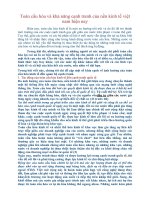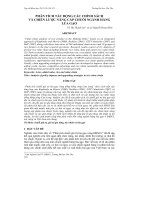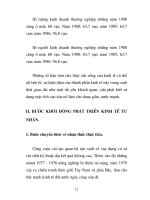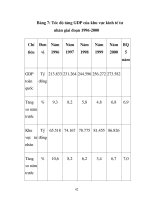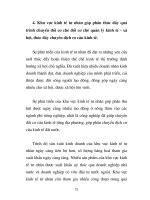Phân tích tác động của chính sách thuế đến cơ cấu ngành của nền kinh tế việt nam (tt)
Bạn đang xem bản rút gọn của tài liệu. Xem và tải ngay bản đầy đủ của tài liệu tại đây (239.82 KB, 27 trang )
MINISTRY OF EDUCATION AND TRAINING
THE UNIVERSITY OF DA NANG
NGUYEN THI HUONG
ANALYZING THE IMPACT OF TAX POLICY ON THE
SECTORAL STRUCTURE OF VIETNAM ECONOMY
Major
: Development Economics
Code
: 62.31.01.05
SUMMARY OF ECONOMIC DOCTORAL THESIS
DANANG - 2018
The work was completed at
THE UNIVERSITY OF DA NANG
Supervisor
: Asso. Prof. Dr. Nguyen Manh Toan
Asso. Prof. Dr. Vo Thi Thuy Anh
Reviewer 1: …………………………………………….…………
Reviewer 2: ……………………………….………………………
Reviewer 3: …………………………………………….…………
The thesis will be protected before council marks the thesis school
level meeting at the University of Da Nang, On the day ...... month
...... 201..
Theses dissertation can be found at: National Library of Vietnam;
Learning & Information Resource Centers – The University of
Danang
1
INTRODUCTION
1. Rational
Tax policy actively contributes to the promotion or restriction
of socio-economic activities of different sectors. Several sectors have
favorable conditions for development while several sectors have to
narrow down the scale of production. The magnitude of the impact of
tax policy on different sectors has led to structural changes in the
economy.
Vietnam's tax policy has gone through several stages of
reform. In 2011, the Government issued the Strategy for Reform of
Vietnam's Tax System in the period 2011-2020. Accordingly, the
specific objectives and requirements for tax policy reform emphasize
the development and implementation of tax policies to promote
economic restructuring towards industrialization and modernization
(Prime Minister, 2011). The tax policy for each specific tax is
indicated in the legal documents, in which the tax rate is foremost
mentioned. In the context of high public debt, the revenue from
import tax decreased due to the implementation of trade
commitments in the process of integration. As a result, Vietnam's tax
policy needs to be further adjusted. The Ministry of Finance has
recently proposed a plan to increase the value-added tax rate
(Ministry of Finance, 2017). This plan has been facing opposite
opinions from experts, economic managers, and the public
community. Analyzing and measuring the individual impact of
changes
in
tax
rates
and
the
combined
effects
of
the
contemporaneous changes in the rates of different taxes play an
important role in studying the impact of tax policies on the whole
economy in general and on economic sectors in particular.
2
Over the past few years, there have been many studies
analyzing the impact of tax policies on the economic growth and
development. However, there also have limitations regarding the
content, model, and data.
Addressing the above-mentioned theoretical and practical
issues help the macroeconomic policymakers have a scientific basis
for selecting and implementing a specific tax policy toward a suitable
economic structure for national economic development objectives.
This will promote the economic growth, stabilize the budget revenue,
and increase the household welfare. As a result, the topic "Analyzing
the impact of tax policies on the sectoral structure of the Vietnamese
economy" is necessary both in theoretical and practical perspectives.
2. Research Objectives
The overall objective of this thesis is to analyze and forecast
the impacts of tax policy on the sectoral structure of the Vietnam
economy, which acts as a basis for proposing a number of policy
implications for the Government to select and implement a tax policy
that contributes to promoting the shift of the economic structure
along the direction of industrialization and modernization.
Specific objectives:
Systematize the theoretical and practical reviews of the impact
of tax policies on the sectoral structure
Analyze and forecast the impact of each tax policy on the
sectoral structure of the Vietnam economy.
Analyze and forecast the combined effect of tax policies on
the sectoral structure of the Vietnam economy.
Propose a number of policy implications for the Government
to select and implement a tax policy that contributes to promoting the
3
shift of the economic structure towards modernization and
industrialization.
3. Research questions
Under the impact of tax policies, does the structure of
Vietnam's economy change in the direction of industrialization or
modernization?
Which tax policy should be selected to contribute to promoting
the transformation of Vietnam's economic structure towards
industrialization and modernization?
4. Objects and scope of the study
4.1. Objects of the study
The thesis focuses on the impact of tax policies, under the
"Reform Strategy of Vietnam's Tax System in 2011-2020" and the
draft of “Law on Amendments and Supplements to a number of
articles of the Law on Value Added Tax, the Law on Corporate
Income Tax, the Law on Personal Income Tax and the Law on
Natural Resource Tax " on the sectoral structure of the Vietnamese
economy.
4.2. The scope of the study
In terms of the content: This study focuses on the change in
tax rates of four types of tax including import tax, value-added tax,
corporate income tax, and personal income tax. The study does not
investigate the tax administration in tax policies. When considering
the impact of tax policies on the structure of the economic sector, the
study also investigates the structure of economic sector in the
relationships with the economic growth, budget revenue, and
household welfare.
In terms of space: Vietnam's economy which is specified into
4
sixty-three economic sectors. Such sectors were further grouped into
twenty-five sectors according to their functions, characteristics, and
concerns to present in the results.
In terms of time: the tariffs used in this study are established,
based on the current tax reform strategy of Vietnam (2011-2020) and
the draft of tax law in 2017. The results of simulations are presented
in time orders to examine the short-term and long-term changes.
5. Research approach and methodology
5.1. Research approach
This study employs an ex-ante approach to stimulate, predict,
quantify, and analyze the impact mechanism of different tax policies
on the change in the price system, income, and the structure of the
economic sector, exports, imports, and GDP.
5.2. Research methodology
The main method used in this study is modeling and
simulation using the Dynamic Equilibrium Model (DCGE).
After conducting the simulation of the impact of tax policies
using the DCGE model, the study uses the descriptive statistics
method with tables and graphs to synthesize, analyze, and evaluate
simulation results.
In addition, the study also uses methods of synthesis, and
comparison to systematize the theory of tax policy, sectoral structure,
the impact of tax policy on sectoral structure and overview of
empirical research of the impact of tax policy on the sectoral
structure, evaluate secondary data relating to the current status,
trends, and factors affecting tax policy and economic structure of
Vietnam.
6. The contribution of the thesis
5
6.1. New contributions on the academic side
The study has clarified the theoretical and practical basis for
indicating the impact mechanism and the analyzing methods of the
impacts of tax policies on the sectoral structure.
The study has clearly analyzed the mechanism of impact of tax
policies on the economic, the economic structure. This is the basis
for tax policy researchers to explain the causes and impact results in
empirical research.
The study also sheds light on a new research direction to use
the DCGE model in analyzing and predicting the impacts of the tax
policies on the sectoral structure of the Vietnam economy.
6.2. New contributions on the practical side
The study has summarized tax policies and factors that affect
Vietnam’s tax policy to develop simulation scenarios about changing
tax rates in line with the current context.
The study has summarized and analyzed the current situation
as well as the guidelines, and orientations for economic development
and changing Vietnam’s economic structure, leading to the
assessment of the impact of tax policies as well as the selection of an
appropriate tax policy in the current condition of the Vietnamese
economy.
The study has developed a complete set of data on production
– distribution – consumption in the Vietnamese economy (Vietnam
2012 Social Accounting Matrix). This is a vital set of data that
researchers can use to simulate the impact of the economic policies
based on the economic models.
The study also develops the dynamic CGE model for multisectors and multi-household groups. This allows for the simulation
6
and analysis of the impact of economic policies on each sector and
each household group, the shifting method of each industry and the
whole economy in the long run. It also allows for the explanation for
resource allocation mechanisms when tax policies change to the
economic structure. This is an empirical model for researchers to
simulate the impact of changes in tax rates and taxes on the
Vietnamese economy in general and on each sector in particular. As
a result, researchers and policymakers may consider selecting the
different tax rates that are the most suitable with development goals
of Vietnam.
The study significantly contributes to the study and application
of the assessment and prediction of the impact of tax policies in the
Vietnamese context.
The study analyzes and predicts the impact of tax policies on
Literature review and research overview of the impact of tax policies
on the sectoral structure through the development, simulation, and
evaluation of tariff scenarios about the impact of each different tax
rates on the sectoral structure. This is empirical evidence that proves
theoretical issues on the impact of tax policies. Research results
show that the reduction of tax rates of import tax, corporate income
tax, and personal income tax have positively impacted the economic
restructuring toward the industrialization and modernization. In
particular, with the reduction of the rate of import tax, capitalintensive sectors are more likely to develop than the labor-intensive
sectors. The study also provides important evidence for a current hot
issue in Vietnam, namely the negative impact of increasing valueadded taxes on the structure of the economic sector, the economic
growth, and the household welfare.
7
The outcome of the study is a valuable scientific argument for
the Government to select and implement a tax policy that contributes
to promoting the shift of the economic structure along the direction
of industrialization and modernization.
7. The structure of the thesis
Apart from the opening and conclusion, the thesis is structured
into four chapters:
Chapter 1. Literature review and research overview of the
impact of tax policies on the sectoral structure
Chapter 2. Research design
Chapter 3. Assessing the impact of tax policies on the sectoral
structure of the Vietnam economy
Chapter 4. Implications
CHAPTER 1. LITERATURE REVIEW AND RESEARCH
OVERVIEW OF THE IMPACT OF TAX POLICIES ON THE
SECTORAL STRUCTURE
The main contents of Chapter 1 are: (1) systematizing the
basic theoretical content on the impact of tax policy on the sectoral
structure; (2) synthesizing domestic and international research on the
impact of tax policies on the sectoral structure. On that basis, this
thesis aims at determining the contents and methods of research in
the implemented works; pointing out the research gap of the tax
policies’ impact on the structure of Vietnam economy that the thesis
is addressing.
1.1. Tax policy
1.1.1. Taxation and basic functions of taxation
1.1.2. The concept of tax policy
Tax policy is a part of fiscal policy, which is the sum of the
8
views, ideas, solutions,and tools that the state uses to make decisions
on revenue mobilization to meet the spending needs, to regulate
income, allocate resources and protect production.
1.1.2. The content of tax policy
One of the most important aspects of tax policy is
determining the level of tax regulation, which is reflected in the
quantification of the effects that tax policy brings.
1.1.3. Factors influencing tax policy
1.2. Sectoral structure
1.2.1. Definition of sectoral structure
1.2.2. Factors affecting sectoral structure
Group of internal factors: market factors and consumer
demand; the level of the productive forces along with the appropriate
movement of production relations; mechanism, policy, and
institutional factors.
Group of external factors: social and political trends in the
region and in the world; globalization and internationalization of
productive forces; the achievements of the revolution of science and
technology, the explosion of information technology.
1.2.3. Indicators defining the economic structure
- Structure of output by sector: structure of GO, the structure
of GDP.
- Structure of foreign trade by sector: structure of export,
structure of import.
1.3. The impact of tax policy on the economy, sectoral structure
1.3.1. The impact of tax policy on macroeconomic indicators,
sectoral structure
1.3.1.1. The impact of tax policy on economic growth, state budget
9
1.3.1.2. The impact of tax policy on export and import
1.3.1.3. The impact of tax policies on the sectoral structure
1.3.1.4. The impact of tax policy on income distribution, and
household welfare
1.3.2. Mechanism of the impact of each tax on the economy and
sectoral structure
1.3.2.1. For import tax
1.3.2.2. For VAT
1.3.2.3. For CIT, PIT
1.4. Overview of empirical studies assessing the impact of tax
policy on sectoral structure
1.4.1. Overseas studies
1.4.1.1. Studies on the impact of indirect tax policies on the structure
of the economy
1.4.1.2. Studies on the impact of direct tax policies on the structure
of the economy
1.4.1.3. Studies related to methods of analyzing the impact of tax
policy
1.4.2. Studies in Vietnam
1.4.2.1. Studies related to economic structure and economic
restructuring
1.4.2.2. Studies on the impact of tax policy on economic
development, the economic structure of Vietnam
1.4.3. Some conclusions from the review of empirical research and
the research direction of the study
Most of studies analyze the impact of a specific tax policy on
the economy. As a result, study the combined effect of tax policies
will be the new contribution of this research.
10
Up to now, two groups of methods have been commonly used
to study this problem: the first group is based on Ex-post
investigation, using the econometric models to verify and assess the
impact; the second group of methods is based on Ex-ante approach,
using CGE or IO models for simulation and forecasting. The CGE
model has many advantages.
However, studies using the CGE model have the following
limitations: (1) use of I/O table or SAM 2007 backwards, (2) some
studies only apply the static CGE model (3) studies using the CGE
model has not elaborated on the impact of all tax policies on the
structure of the economy. (4) The level of detail by sector is limited
because of the structure of the economy by sectoral groups or using
GTAP data.
With this discussion, the study selects and develops the
dynamic CGE model to study the impact of tax policies on the
sectoral structure of the Vietnam economy. Data for the model is the
2012 Vietnam SAM. When developing the CGE model, the author
explains the mechanisms for allocating resources when tax policies
are changed on the transformation of economic structure. This is the
usage difference of CGE model in this study compared to previous
CGE models. In addition, the SAM 2012 table built from Vietnam
IO 2012 table is also a new contribution.
CHAPTER 2. RESEARCH DESIGN
Based on the systematization of the theory and a review of
empirical studies to find the research gaps in chapter 1, chapter 2
presents the research model, input data for the model and the
construction of the scenarios to study the impact of tax policies on
sectoral restructuring in Vietnam economy.
11
2.1. Research process
2.2. The dynamic general equilibrium model
The model consists of three equilibrium blocks: the intertemporal equilibrium block, the intra-temporal equilibrium block,
and the steady-state equilibrium block, which allows simulation of
the activity and long-term relationship of the five major entities
forming the economy: producer, government, household investment,
and the rest of the world (ROW).
The model in this study is a multi-sector model. As a result,
the model allows simulating and analyzing of the impact of
economic policies on each sector as well as the long-term
transformation of the sectors and the economy; explaining the
mechanisms for allocating resources when tax policies are changed
on the transformation of economic structure. This is the usage
difference of CGE model in this study compared to previous CGE
models.
2.2.1. The Inter-Temporal Equilibrium block
Household consumption and saving
Firms and investment
Foreign debts
Capital stock owned by each household groups
2.2.2. The Intra-Temporal equilibrium block
The theoretical structure of The Intra-Temporal equilibrium
block is based on the static CGE model in studies of Dervis, Melo &
Robinson, 1982; Vargas & F. Schreiner et al., 1999; Hosoe, 2001;
Chen, 2004 and Toan, 2005.
Producers
Government and Household
12
Demand
Supply
Market clearing
Equilibrium prices
2.2.3. The steady-state equilibrium block
At every point of time, equilibrium must be achieved across all
commodity markets, labor markets and the foreign exchange market.
In the long term, the economy must reach a stable equilibrium, where
the following conditions must be met:
Steady state condition for sectoral capital stock
Steady state condition for capital stock owned by each
household group
Steady state condition for foreign debt
Steady state condition for interest rate
2.3. Data for the CGE model
2.3.1. Social Accounting Matrix for Vietnam
In Vietnam, CIEM has collaborated with international
organizations to develop and publish SAMs for Vietnam in 1999,
2000, 2003, 2007, and 2011. In order to serve the research objectives
of the dissertation, from the Input-Output Table 2012 released by the
General Statistics Office in 2015, the 2011 SAM for Vietnam
(CIEM, 2012), The Ministry of Finance’s data on the state budget
revenue and expenditure for the year 2012, The State Bank of
Vietnam’s data on Vietnam’s 2012 Balance of Payment, the author
self-conducts the 2012 SAM for Vietnam.
2.3.2. Construction of the 2012 Macro SAM for Vietnam
The macroeconomic SAM Vietnam 2012 does not detail
industries, households and factors of production.
13
2.3.3. Construction of the 2012 Micro SAM for Vietnam
The 2012 SAM for Vietnam are classified in detail. The
classification in the 2012 SAM for Vietnam includes activities
classification, commodities categorization disaggregated into 63
activities, 63 commodities.. Classification of factors of production
consists of seven factors, including six types of labours which is
classified by geography (urban-rural) and education levels (primary,
secondary and tertiary). Household classification consists of 20 types
of household, which is classified by three criterion, urban-rural;
agricultural and non-agricultural; and 5 income quintiles (from the
poorest (quintile 1) to the richest (quintile 5)).
2.4. Construction of research scenarios
Scenario 1 (S1): The import tax rate is gradually reduced to
0%, , and the other tax rates remain unchanged.
Scenario 2 (S2): The VAT rate is increased to 12%, and the
other tax rates remain unchanged.
Scenario 3 (S3): The CIT rate is reduced to 17%, and the other
tax rates remain unchanged.
Scenario 4 (S4): The personal income tax rate is reduced to
20%, and the other tax rates remain unchanged.
Scenario 5 (S5): Tax rate for all four taxes is changed s as in
S1, S2, S3, S4.
Scenario 6 (S6): The VAT rate is kept constant and other tax
rates decrease as in S1, S3, S4.
CHAPTER 3. ASSESSING THE IMPACT OF TAX POLICIES
ON THE SECTORAL STRUCTURE OF THE VIETNAM
ECONOMY
Based on the proposed research hypothesis, the CGE model is
presented in Chapter 2 along with the GAMS software to solve the
14
model. Chapter 3 will be the focus of assessing the impact of each
tax policy as well as overall tax policy on the sectoral change in
Vietnam economy.
3.1. Current situation of tax policy and economic structure of
Vietnam
3.1.1. Tax policy of Vietnam since 1990
3.1.2. The sectoral structure of the Vietnam economy
3.2. Analysing the impact of each tax policy on the sectoral
structure of the Vietnam economy
3.2.1. The simulation results of the impact of tariff reduction
The reduction of tariff rates leads to the economy shifting
towards the expansion of industry sector; and shrinkage of
agriculture and service sector. The proportion of service sector
decreases but output in this sector tends to increase; in particular, the
prioritized service sectors expand significantly. This shows that the
economy has made positive changes in the integration process; the
sector structure is no longer biased towards traditional services. In
the industry sector, sectors producing production material have
promoted their key role and development, especially the machinery
sector. The S1 result also implies that Vietnam industry sector no
longer relies on advantageous industries but gradually shifts towards
industrialization and modernization in the process of economic
integration and reduction of tariff barriers.
3.2.2. The simulation results of the impact of increasing the valueadded tax
Raising the VAT rate causes the economy to shift in the long
run towards the direction of increasing the proportion of agriculture
and service sectors (up 0.31%); reduce the proportion of industry
sector. In the industry sector, the impact of increased VAT improves
15
the proportion of consumer goods (seafood processing, food
processing, textiles, and footwear) and reduces the proportion of
manufacturing sectors (metallurgy, machinery). The S2 result also
implies that labor-intensive sectors benefit and expand production
more than capital-intensive sectors.
3.2.3. The simulation results of the impact of corporate income tax
reduction
The reduction of the corporate income tax rate in S3 has made
the economy move towards increasing the proportion of industry
with negligible level. The result of S3 implies that reducing CIT has
a negligible impact on production as well as sector restructuring in
Vietnam economy.
3.2.4. The simulation results of the impact of personal income tax
reduction
The reduction of the PIT rate in S4 has made the economy
move towards increasing the proportion of industry but the increase
is negligible. The results of S4 imply that reduction of personal
income tax has a negligible impact on the production as well as on
the sector restructuring in Vietnam economy.
3.2.5. Synthesize results of simulating impacts of each tax on the
economic structure
The change in import tax has made the structure of industry
change towards industrialization and modernization. Meanwhile,
changing the VAT makes the economy in the long run reduce the
proportion of industry in GDP. The change in income tax has made
the structure of Vietnamese economy unchanged.
3.3. Evaluating the combined impact of tax policies on the
sectoral structure of the Vietnam economy
16
3.3.1. Simulation results in 5
Increasing VAT along with the reduction of import tax,
corporate income tax and PIT makes the economy move towards the
expansion of industry sector; and the shrinkage of agriculture and
service sector. The highlight of this scenario is the strong
development of the textile industry which, in turn, promotes
industrial development. The S5 results also imply that, in addition to
reducing import tariffs as committed, if the government adjusts tax
policies under the tax reform strategy and draft law then most sectors
will reduce output (noticeably in cultivation and machinery
production); and the textile and garment sector will gain advantages
and become a key sector in the economy. The positive impact of the
reduction of import tax rates (S1) could be eliminated due to the
unfavorable impact of increasing the VAT rate.
3.3.2. Simulation results in 6
Reduction of import tax, corporate income tax, personal
income tax while maintaining in S6 will cause the economy to move
towards of the expansion of industry sector. The highlight of this
scenario is that industry sector, which plays an important role in the
industrialization and modernization strategy of the country will
increase output. The S6 results also imply that no VAT increase
under the draft law of Finance ministry would create incentives for
product development and that capital-intensive sectors have a greater
chance of developing than those of more labor-intensive sectors.
3.3.3. Synthesize the results of analyzing the simultaneous impacts
of taxes on the structure of the economy
The reduction of import tax, corporate income tax and
personal income tax while unchanged VAT (S6) may be a reasonable
17
choice in the long-term strategy of the Government. The increase in
VAT should be considered more carefully in the current context.
3.4. The impact of tax policies on macroeconomic indicators
Lowering the import tax (S1) enhanced GDP by 7.87% in the
long term. Reducing tariffs inevitably reduces the budget (down by
1.44% in the short term). Therefore, Vietnam needs to focus on and
promote appropriate policies or save money to make up for this
shortage. However, the reduction of tariffs is accompanied by an
increase in trade and economic expansion, thereby facilitating the
increase of other taxes. Therefore, in the long term, reducing tariff
can improve the budget by 3.97%.
Raising the VAT rate from 10% to 12% (S2) has a negative
impact on production (GO, GDP decrease), a decrease in exports is
likely to cause a trade deficit. In the short term, government revenue
increases by about 7%. This increase is diminished by the decline in
economic activities, particularly in the industry sector, which
accounts for a large proportion of the economy (more than 45 %). As
a result, in the long run, total government tax revenue does not
improve significantly compared to the base year (up 0.12%) due to
the decrease in revenues from the tariff, corporate income tax, and
personal income tax.
Reduction of corporate income tax (S3) causes a slight
decrease in GDP (-0.03%) in the short term but an increase in the
long run, while both import and export values improve. However,
this scenario negatively affects the state budget with a deficit of
about 12%.
Reduction of personal income tax (S4) affects insignificantly
the macroeconomic indicators such as GDP, export and import
18
values. The state budget also reduces insignificantly because PIT
accounts for a small proportion of total state budget revenues.
Increasing VAT, reducing other taxes (S5), has a negligible
impact on GDP and other macroeconomic variables, with a budget
decrease of 15.32%.
Maintaining the VAT rate, reducing other taxes (S5)
dramatically enhanced GDP (by 8.27%), exports and imports
increases sharply in the long term, the state budget decreases by
11.28%.
It can be said that scenario 6 is the most feasible option in
terms of welfare (increase by 4.21%) and long-term strategy of the
government. However, the budget deficit is too large (11.28%), so
policymakers should consider choosing and changing other taxes to
deal with this situation.
The results indicate that only a VAT increase scenario reduces
welfare; all the remaining scenarios of changing tax rates can
increase welfare for all types of households. Specifically, the welfare
of the rich households (H5, H10, H15, H20) in all areas, the sector
increases more strongly than the other groups, thus widening the
income gap.
CHAPTER 4. IMPLICATIONS
This chapter outlines the basics of policy implications, leading
to the proposing a number of policy implications for the Government
to select and implement a tax policy that contributes to promoting the
shift of the economic structure along the direction of industrialization
and modernization.
4.1. Background for policy implications
4.1.1. Main findings from research results
19
After evaluating the simulation results of the impact of tax
policies on sectoral structure changes in the Vietnamese economy in
relation to economic growth, government budget revenue, and the
household welfare, the main results are as follows:
The changes in the indirect tax rates (VAT, import tax) have a
stronger impact than changes in direct tax rates (CIT, PIT).
The reduction of import tax rate leads the economy move
toward the increase of the proportion of industry and the reduction of
the proportion of agriculture and services.
The reduction of the rates of import tax, CIT and PIT have a
positive impact on the economic sector restructuring toward the
industrialization and modernization, promoting economic growth and
improving household welfare.
Increasing VAT rate negatively affects the sectoral structure,
economic growth, and household welfare.
Increasing VAT rate along with reducing import tax rate, CIT
rate and PIT rate also results in the increase in the proportion of
industry and the reduction in the proportion of other sectors in the
economy. The increase in a VAT rate results in the decrease in
national budget revenue as opposed to the expected increase.
Maintaining the VAT rate and reducing the rates of other taxes
help promote the process of economic sector restructuring toward the
industrialization and modernization. These also result in the strong
increase in the welfare and GDP in the long run. The national budget
has decreased but the percentage of the decrease is lower than the
percentage of the increase in the VAT rate.
4.1.2. The orientation of the sectoral restructuring in the
Vietnam economy
20
By 2020, the share of the agriculture sector is at 10%; the
share of industry and construction will be planned to increase to
45%, and the share of services will be planned to increase to 45%.
4.1.3. The state budget revenue and expenditure in the period of
2011-2015 in Vietnam
The total state budget revenue in 2011 - 2015 increased twice
compared to the period 2006-2010, the total revenue from VAT and
PIT increased.
The share of regular expenditures increased and accounted for
over 70% of total state budget expenditure.
4.2. Implication
Firstly, the government should have appropriate support
policies to promote and develop hi-tech industries in order to
increase productivity and competitiveness of domestic goods and
boost exports. The government should also consider policies that
support R & D and create conditions for adding value to exports until
when tariff decreases.
In addition, the revenue from taxes will decrease when tariff
lines are reduced to 0%. This affects the national budget revenue.
This also requires the government to seek for other sources of
revenue such as increasing the revenue from other taxes, increasing
debts or cutting regular expenditure in order to stabilize the state
budget balance. However, simulation results show that the reduction
of import tariffs is accompanied by an increase in trade and
economic expansion, which in turn has facilitated the increase of
other taxes. Therefore, in the long term, although reducing import
taxes, the budget will increase 3.97%. Moreover, the reality shows
that in the period 2011-2015, total state budget revenues increased,
21
of which total revenue from VAT increased (while not increasing
the tax rate). Therefore, the Government does not necessarily
increase the tax rate of other taxes to offset the reduction of import
revenue. In the context of rising public debt, the solution to increase
debt can not be implemented. As a result, depending on the stage and
policy objectives, these fiscal balance measures need to be taken
into account to ensure macro stability and encourage the production
and consumption. This helps avoid contradictions with efforts of
other policies. In the short term, policies should focus on cutting
regular expenditure.
Secondly, in the context of the current Vietnamese economy,
the increase in the VAT rate makes the structure of the economy, in
the long run, shift towards increasing the share of GDP in agriculture
and services. Thus, the sectoral structure under the influence of
increasing VAT is not really in line with the target shift from
agriculture to industry and services as set out in the socio-economic
development strategy in the period 2011-2020 in Vietnam.
In addition, increasing the VAT rate could help improve tax
revenue for the government budget (about 7%) in the short term.
However, in the long run, the increase in the VAT rate distorts the
price system of goods which adversely affects the production. As a
result, in the long run, total government tax revenue was not
significantly improved (0.12%) due to lower revenue from import
tax, corporate income tax, and personal income tax. Therefore, if the
policy of increasing VAT rate is implemented, the target of using
VAT policy for increasing the state revenue may not be as expected.
With this above discussion, the Government should consider
the policy of increasing the VAT rate when the policy targets are
22
oriented towards the sectoral structure in the direction of
industrialization and modernization and increase the tax revenue.
Thirdly, the general trend of countries is to gradually reduce
the income tax rate to increase the attractiveness of the investment
environment. In the context of the current Vietnamese economy, the
reduction of the income tax rate has a negligible impact on economic
growth as well as the restructuring of the sector. However, when
combining with the scenario of reduction of import tax rates, the
combined effect of these policies is greatly activated, resulting in the
sectoral
structure
changes
towards
industrialization
and
modernization, the stronger economic growth and the increase in
household welfare. Therefore, the Government should incorporate
income tax policies with other tax policies to enable the development
of the economy.
Finally, reducing import taxes is inevitable in the context of
Vietnam's current international economic integration. However, the
reduction of import tax rate should be considered simultaneously
with other tax policies. In all proposed scenarios, the scenario with
no change in the VAT rate and the reduction in the rates of the
import tax, CIT, and PIT is the most reasonable option in the current
period for the Government with respect to the restructuring the sector
toward the industrialization and modernization as well as
macroeconomic indicators. However, due to the significant decrease
of the national budget, the government should consider cutting
regular expenditures and calling for other sources of revenue.
CONCLUSION
1. The research results
The study systematizes a number of theoretical reviews on the
23
impact of tax policies on the sectoral structure. In particular, the
study synthesizes concepts, contents, factors affecting tax policies
and the sectoral structure. It also explains the impact mechanism of
tax policies on the economy and the sectoral structure.
The study synthesizes and analyzes the current situation of tax
policies and the sectoral structure of the Vietnam economy as a basis
for developing simulation scenarios about the changes in tax rates
and the selection of appropriate tax policies in the current context.
The study has established the 2012 SAM for Vietnam based
on the clear and reliable published data to simulate the impact of tax
policies based on the DCGE model. This is a vital dataset for
researchers using to simulate the impact of economic policies based
on economic models.
The study uses the DCGE model, the VSAM2012 data set and
the GAMS software to analyze and estimate the impact of each tax as
well as the combined effect of tax policies on macroeconomic
indicators, household groups and the trend of restructuring the sector
in both short-term and long-term through the simulation of tax rate
change scenarios. Estimated results provide empirical evidence to
demonstrate the mechanism, magnitude, and appropriateness of tax
policies in Vietnam.
Based on empirical simulation results, the study suggests a
number of implications for the selection of appropriate tax policies
(The VAT rate is kept constant and reduction of the rates of import
tax, CIT, and PIT) to restructure the economic sector toward the
industrialization and modernization, stabilize the macroeconomy and
improve the household welfare.
2. Limitations
